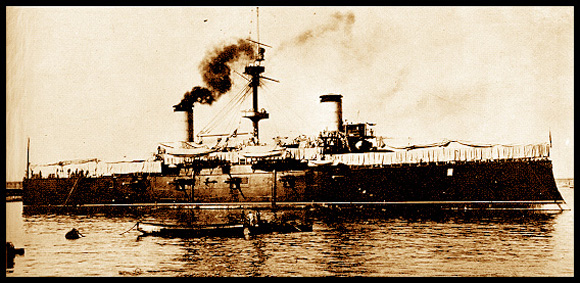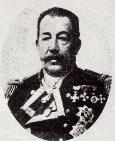
CRISTOBAL COLON

Other views of the CRISTOBAL COLON:
Chart of hits |||
Awash
after the Battle of Santiago |||
Colon's Officers
on Deck
GENERAL:
On paper the most fearsome vessel in Admiral Cervera's
fleet, CRISTOBAL COLON was the only authentic Spanish armored cruiser.
Extensively armored, she was the best cruiser in the Spanish fleet, but
the 254 mm main guns were never installed because a conflict with Armstrong.
Colon had many sisterships: GIUSSEPPE GARIBALDI, VARESE and FRANCESCO FERRUCIO
of Italy, GENERAL GARIBALDI, GENERAL SAN MARTIN, GENERAL BELGRANO and GENERAL
PUYRREDON of Argentina, and KASUGA and NISSHIN of Japan. She was lost in
the Battle of Santiago.
BACKGROUND:
 CRISTOBAL
COLON was the third ship out of Santiago Bay on July 3rd, 1898. She took
advantage of the confusion of battle and her speed, and for a while it
appeared she may escape. Soon, however, the COLON's fireboxes had used
up the last of her high-grade Cardiff coal and when the stokers were forced
to switch to inferior coal obtained in Cuba her speed dropped off dramaticly.
The COLON's commander, Capitán de Navío Emilio Díaz
Moreu, also made a serious tactical error, hugging the coastline
instead of heading for the open sea. Just before 2 PM the American fleet
came within firing range and the Captain, declining a fight, turned his
undamaged ship for the rocks, opened the sea cocks to scuddle the ship,
and hauled down his flag. He was about 75 miles west of Santiago. An American
salvage crew quickly went aboard, but later that evening the inexplicable
decision was made to tow the CRISTOBAL COLON off the rocks although watertight
integrity had not been restored. She quickly capsized and sank, a total
loss.
CRISTOBAL
COLON was the third ship out of Santiago Bay on July 3rd, 1898. She took
advantage of the confusion of battle and her speed, and for a while it
appeared she may escape. Soon, however, the COLON's fireboxes had used
up the last of her high-grade Cardiff coal and when the stokers were forced
to switch to inferior coal obtained in Cuba her speed dropped off dramaticly.
The COLON's commander, Capitán de Navío Emilio Díaz
Moreu, also made a serious tactical error, hugging the coastline
instead of heading for the open sea. Just before 2 PM the American fleet
came within firing range and the Captain, declining a fight, turned his
undamaged ship for the rocks, opened the sea cocks to scuddle the ship,
and hauled down his flag. He was about 75 miles west of Santiago. An American
salvage crew quickly went aboard, but later that evening the inexplicable
decision was made to tow the CRISTOBAL COLON off the rocks although watertight
integrity had not been restored. She quickly capsized and sank, a total
loss.
ADVANTAGES/DISADVANTAGES:
The CRISTOBAL COLON was modern and speedy, almost brand new and the
finest Armored Cruiser in the Spanish fleet. However, the Ministry of Marine
had rejected the 10 inch guns of her main battery and the war broke out
before replacements could be obtained. Thus, she sailed for Cuba with wooden
dummies in their place, a major disadvantage in battle!
TECHNOTES:
| Classification: |
|
Steel Armored Cruiser |
| Laid down: |
|
1895 |
| Launched: |
|
September, 1896 |
| Completed: |
|
May 1897 |
| Rig: |
|
One military mast |
| Armament: |
|
Two 25.4 cm (10 inch) Armstrong guns (Not installed) |
|
|
Ten 15.2 cm (6 inch) guns |
|
|
Six 12.0 cm QF guns |
|
|
Ten 57 mm Nordenfeldt QF guns |
|
|
Ten 37 mm guns |
|
|
Two 22 mm machine guns |
|
|
5 torpedo tubes |
| Contractor: |
|
Cantieri Sestri Ponenti of Ansaldo Shipbuilder, Genoa,
Italy |
| Length: |
|
100 meters |
| Beam: |
|
18.20 meters |
| Mean draft: |
|
7.75 meters |
| Displacement: |
|
6,840 tons |
| Complement: |
|
543 Officers and Men |
|
|
under the command of Capt. Emilio Diaz Moreu. |
| Engine type: |
|
14,000 hp. engines, twin screw. |
| Speed: |
|
19.5 knots |
| Endurance @ 10 knots: |
|
8,300 miles |
| Armor: |
|
150 mm steel compound side belt, 150 mm turrets, 30 mm
deck. |
Sources used for this information (see Bibliography for full source
list)
Blow, Michael, "A Ship to Remember", New York: William Morrow and Company,
Inc., 1992.
Clerk of Joint Committee on Printing, "The Abridgement of Message
from the President of the United States to the Two Houses of Congress",
Washington: Government Printing Office, 1899. 4 vols. (all are documents
relating to the war).
González López, Manuel P., Personal Internet Contact.
Pérez-Reverte, Arturo, "July 3, 1898 - The Ultimate Day for
Imperial Spain, The Battle of Santiago" (image of crew in action). The
image was sent to us by Federico Iborra.






